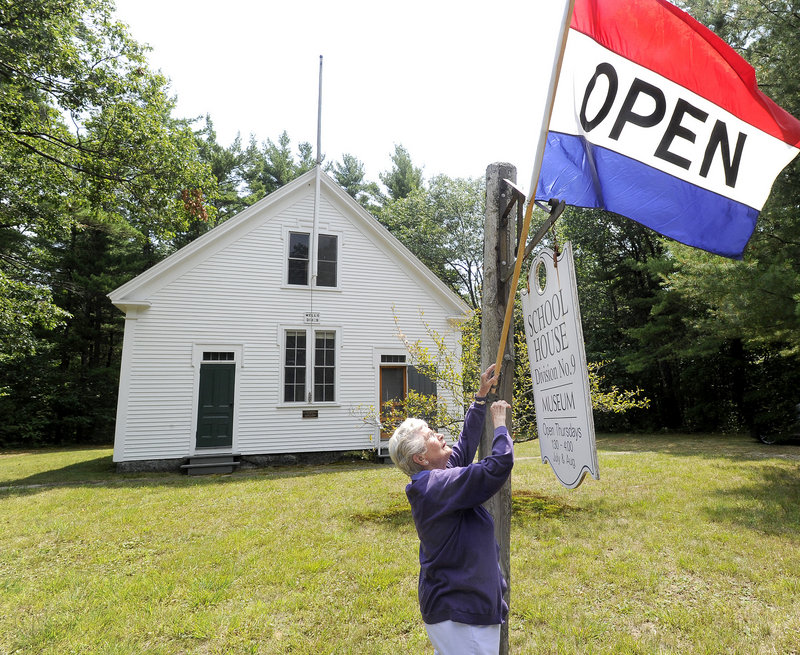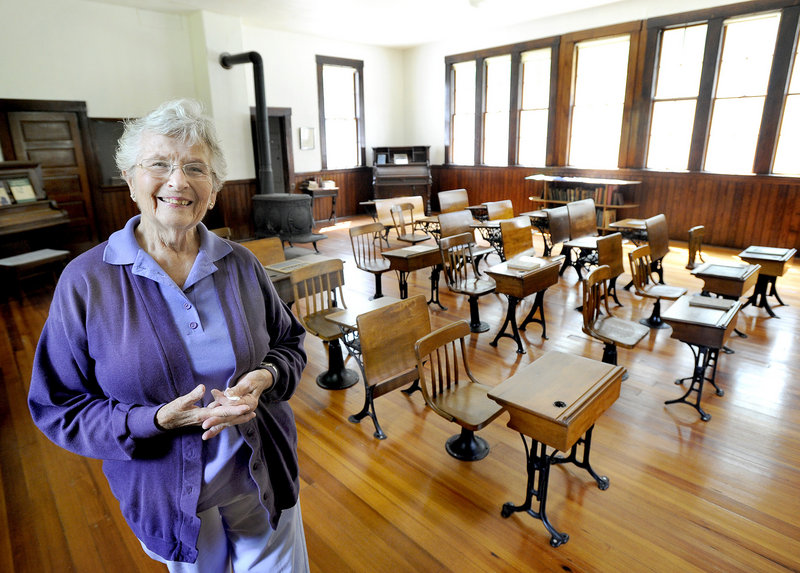Summer school is in session at the Wells Division 9 Schoolhouse, but classes there primarily focus on history.
Each Thursday, from 1:30 to 4 p.m., former teachers, docents and students of the town’s only remaining one-room schoolhouse volunteer to give tours of the building and talks detailing how lessons offered there nearly 100 years ago contrast with modern educational methods.
Long before school buses, cafeteria lunches and iPads were the norm, rural students walked to one-room schools, like the District 9 model, carrying their lunch in a pail. And if pupils had an apple in their possession, it was something to be eaten, not navigated.
Wells town historian Hope Shelley has spent much of her life recounting the particulars of the town’s history — more recently as one of the voices for the Division 9 School.
The position gives Shelley, a Wells native and valedictorian of the Wells High School Class of 1952, an opportunity to share about a simpler time that few people still living remember and even fewer have experienced.
Shelley’s formative years were spent in a singular environment, shared with multiple ages and familiar faces.
The year after Shelley graduated, such town-funded learning environments were gone forever.
“There were once 17 of these rural one-room schoolhouses in town, dating from 1872,” said Shelley. “But by 1953, they had all been phased out in favor of consolidated schools that were thought to offer more comprehensive educational opportunities for students.”
Shelley didn’t attend the Division 9 model, but she did attend two that were similar — in Districts 3 and 4 — noting, “All of them were cookie-cutter identical in look and function. There was just one teacher in each school for students ranging from kindergarten through grade 8.”
The schools did not have running water or electricity in those days.
Students drank water that was either hand-pumped or, as with the Division 9 school, drawn from a well via a bucket, with a metal dipper serving as a drinking glass.
Two-seater outhouses, attached to opposite ends of the building, provided separate toilets for boys and girls, who also entered the school from separate doors. And heat was supplied by a woodstove at the front of the room.
“Some of the little schoolhouses were razed following years of neglect, and others were converted into private homes or businesses,” Shelley said.
For a time, the building served as a meeting place for a veterans organization, which tore down one of the outhouses and installed a kitchen with indoor plumbing and electricity.
In 1976, the little school was adopted by the Wells & Ogunquit Bicentennial Committee and restored as a living history museum.
“We wanted to preserve one of these schools for future generations — so people can see what it was like to attend one of these schools,” said Shelley. “This building is now on the National Register of Historic Places.”
The school offers a snapshot into the past, with old wood-on-wrought iron desks set in tidy rows, each fitted with an inkwell. The occasional individual-sized slate blackboard — the predecessor to paper and laptops — sits on some desks as though a student may have set it aside for recess.
Located on busy Route 9, the Division 9 School was built around 1900 for a cost of $848.72, including the half-acre of land it sits on and its furnishings.
But the cost of upkeep is considerably more for a building that is opened to the public just two months each year.
Shelley said the town owns the building, but advocates of the old school are always trying to find ways to raise public support for its upkeep and continued use as a living history museum.
Shelley recalled one ill-conceived fundraiser.
“One winter, we held a bake sale there, but nearly froze to death in the attempt,” said Shelley. “These days, we just put a basket out for folks to make a donation if they like.
“Some people are very generous. Last summer, one lady left a $100 bill in the basket. She had attended a one-room school in her youth and saw the value of preserving the experience for future generations to enjoy.”
Shelley hopes that others learn from the woman’s example so that the little schoolhouse can continue educating others about the past.
Staff Writer Deborah Sayer can be contacted at 791-6308 or at:
dsayer@pressherald.com
Send questions/comments to the editors.




Success. Please wait for the page to reload. If the page does not reload within 5 seconds, please refresh the page.
Enter your email and password to access comments.
Hi, to comment on stories you must . This profile is in addition to your subscription and website login.
Already have a commenting profile? .
Invalid username/password.
Please check your email to confirm and complete your registration.
Only subscribers are eligible to post comments. Please subscribe or login first for digital access. Here’s why.
Use the form below to reset your password. When you've submitted your account email, we will send an email with a reset code.